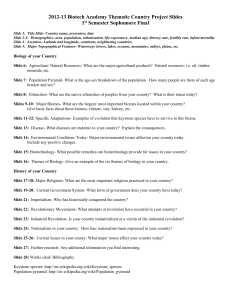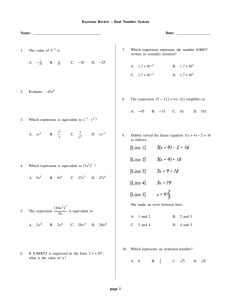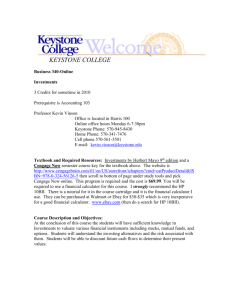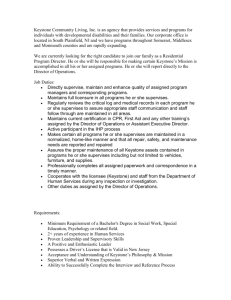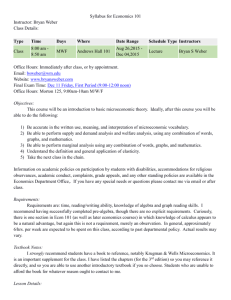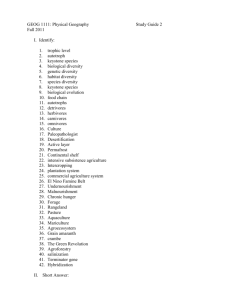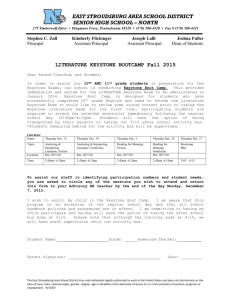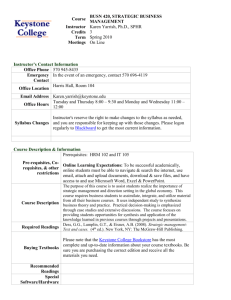Bus 406 Online Syllabus
advertisement
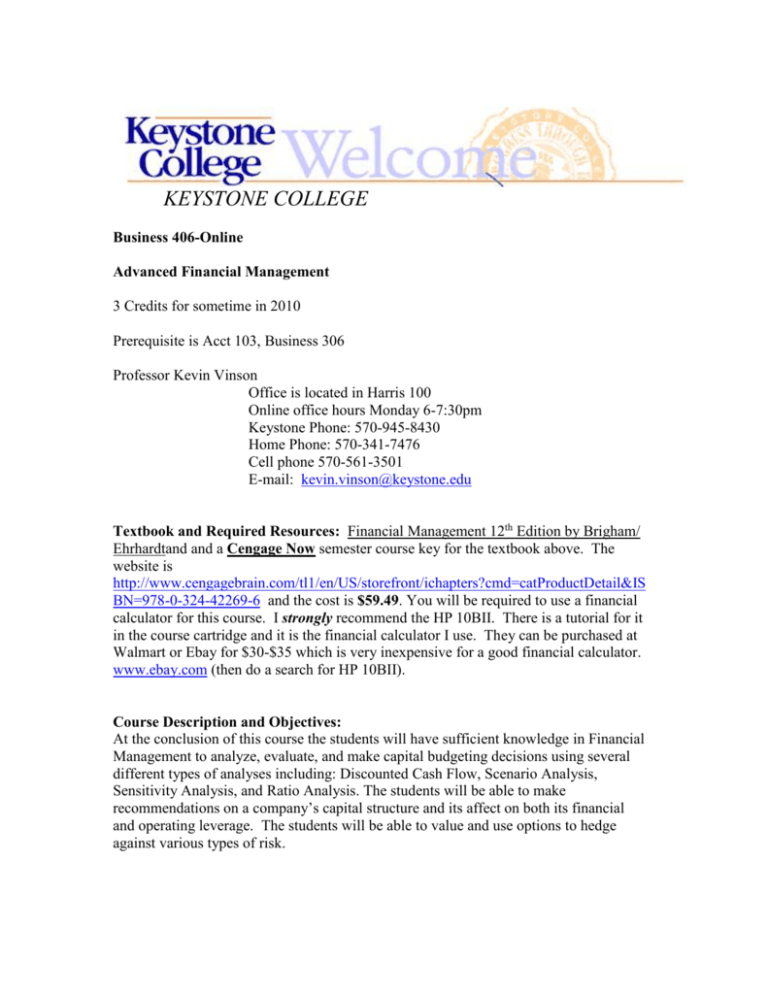
KEYSTONE COLLEGE Business 406-Online Advanced Financial Management 3 Credits for sometime in 2010 Prerequisite is Acct 103, Business 306 Professor Kevin Vinson Office is located in Harris 100 Online office hours Monday 6-7:30pm Keystone Phone: 570-945-8430 Home Phone: 570-341-7476 Cell phone 570-561-3501 E-mail: kevin.vinson@keystone.edu Textbook and Required Resources: Financial Management 12th Edition by Brigham/ Ehrhardtand and a Cengage Now semester course key for the textbook above. The website is http://www.cengagebrain.com/tl1/en/US/storefront/ichapters?cmd=catProductDetail&IS BN=978-0-324-42269-6 and the cost is $59.49. You will be required to use a financial calculator for this course. I strongly recommend the HP 10BII. There is a tutorial for it in the course cartridge and it is the financial calculator I use. They can be purchased at Walmart or Ebay for $30-$35 which is very inexpensive for a good financial calculator. www.ebay.com (then do a search for HP 10BII). Course Description and Objectives: At the conclusion of this course the students will have sufficient knowledge in Financial Management to analyze, evaluate, and make capital budgeting decisions using several different types of analyses including: Discounted Cash Flow, Scenario Analysis, Sensitivity Analysis, and Ratio Analysis. The students will be able to make recommendations on a company’s capital structure and its affect on both its financial and operating leverage. The students will be able to value and use options to hedge against various types of risk. Goals for Business 406 Students will: A. Further expand their knowledge of business terms and apply theories and equations to case analysis. B. Calculate the value of various types of financial options and utilize their ability to hedge different types of risk. C. Calculate Net Present Value, Internal Rate of Return, and Discounted Payback Period to make capital budgeting decisions. D. Analyze the factors that influence a business’ capital structure along with the effects that leverage and changes in the debt ratio affect EPS and shareholder value. Objectives for Business 406 Your objectives in the course are to prove that you are competent to: 1. 2. 3. 4. Perform ratio analysis to evaluate the strengths and weaknesses of companies. Make capital budgeting decisions. Calculate the value of options and use them to hedge different types of risk. Use sensitivity and scenario analysis to recommend a companies’ capital structure and its affect on both financial and operating leverage. Assessments Goals Homework assignments ABCD Exams ABCD Discussion Posts/Questions ABCD Cyberproblems/Case Studies ABCD Objectives 1,2,3,4 1,2,3,4 1,2,3,4 1,2,3,4 Welcome to Business 406 Online For those of you who are new to online learning I would like to spend a little time discussing our new classroom. The main place where we meet each other is in the GENERAL DISCUSSION BOARD. We will post answers to our assigned questions on a specific discussion board entitled HOMEWORK. It is on this board that we will also post comments and or questions to the answers provided. It is this board entitled HOMEWORK that will be part of your final grade. We will have a different discussion board (General) to post everything else including but not limited to information about ourselves and our interests, general questions and answers pertaining to the class (but NOT questions or comments on the assigned essay type questions). This is a cyberspace classroom and we must be extra careful to make sure we address everyone with the respect and consideration we ourselves would like to be shown. We need to know that certain rules will be followed and everyone will be safe to express themselves. There are rules of etiquette that people in polite societies follow and we will also discuss netiquette. (Etiquette for the Internet.) I would like to propose some rules for our cyberspace classroom. Many of you use shorthand when communicating online. I am speaking of BRB which means be right back or maybe a character display like , to express a smile. This is a new type of language. As you read the syllabus you will note that posting your answers and comments to the HOMEWORK discussion board is a portion of your grade in this course. I expect you to become a valued member of this online community and in order to do that you must attend class and post material on the discussion board in a timely manner. I like to run a casual class...so I think abbreviations are OK in speaking with one another. However, when answering the required questions on the HOMEWORK board proper grammar and spelling is required. Please start with the tab on blackboard START HERE to make sure you can use all the tools required for our class. After properly loading the course cartridge and course key please complete the orientation found in the ORIENTATION tab. Class Resources There are two different sites you will be using for this course. The first is blackboard where the two discussion boards are located. In blackboard you can click on Course Documents and find the power points for all 9 chapters. You can open them in blackboard and scroll down them using the mouse but you will not see all of power points on the left. I therefore recommend you save them to your desktop where you can then view them in the usual manner. To do this you 1. Right click the power point chapter you want to view. 2. Then select “save target as”. 3. Then choose your desktop and it will save to your desktop for easy viewing. Cengage Now has a calculator tutorial which I strongly recommend everyone go through before attempting any homework assignments. I have it posted on Blackboard. To access it 1. Login to Cengage Now, (email and password). Do not pick the SSO Cengage Now for this textbook as you normally would to access the course. Instead pick the “students companion website” (it is below the SSO Cengage now option). 2. Under book resources choose the “calculator tutorial” then chose the HP 10BII calculator assuming you have one. Once you are logged into the course there are various resources for you to access to help you throughout the semester. NOTE YOU MUST HAVE YOUR POP-UP BLOCKER OFF at all times when you are in the course to allow course resources to run. To find them 1. Click on the “assignments” icon 2. Then select Practice Chapter you are on. 3. Take the pre-test. Afterwards a personalized study plan will be available to you. It will show your areas of weakness. Note the pre-test does not count towards your grade. It is the post-test that counts towards your grade but you can take it up to 4 times to help improve your grade. 4. After taking the pre-test there is an icon to the left under option 2 (Study Plan) that says ALL CHAPTER CONTENT. Click on it to see the areas you need to focus on based on the pre-test. I also encourage students to review the New Student Blackboard Orientation tutorial before the start of classes to resolve any “technical issues” early on. See the Online Learning web page, FAQ’s at the following link http://www.keystone.edu/about_us/departments_and_offices/faqs.dot?inode=79671&cru mbTitle=Online%20Learning%20FAQ's There is nothing worse than that late for class feeling….especially if you can’t find the classroom. You can get technical support or assistance by contacting IT Helpdesk by phone (570) 945-8778 or helpdesk@keystone.edu For Blackboard assistance http://blackboard.keystone.edu/ or e-mail the Blackboard administrator at blackboard@keystone.edu For many helpful student resources go to: http://www.keystone.edu/onlinelearning/studentresources Student Expectations Online students will be completing online assignments in the form homework, tests, and answering questions and posts in response to the questions in the discussion board HOMEWORK each week/module. Most online students say the most important thing about taking an online class is to set aside time each week to work on the class assignments, just as you would in a regular classroom. You know all of your assignments and their various due dates ahead of time so please prepare/budget your time accordingly. Assignments must be completed by the corresponding due dates to receive credit. It is easy to fall behind and very difficult to catch up. In this course you will probably not be able to work ahead and get all of your course work completed in a shorter time frame because there is a discussion board component that requires weekly submissions. You will be able to work ahead by doing your homework and tests assignments ahead of time as they are all available upon entrance to the class. Do not expect that you can work on this class at your leisure. There are usually 3 assignments and various end of chapter questions for each of the 9 chapters plus Cyberproblems/Case studies for various chapters. This is a complex subject matter and reading, studying and homework will require extensive amounts of time just as it does in a traditional classroom environment. Most people are busy and choose online to fit education into an already busy life. Deadlines are set for class questions and the corresponding posts required by everyone in the class. As stated earlier all assignments, questions and tests must be submitted by the specified due date to receive credit. Make sure you set aside time and make a schedule that works for you to follow the due dates. I am not the only one who answers the questions in general discussion thread. I can, at my discretion award extra points at the end of the semester for students who have been helpful in answering others questions as this can greatly enhance the learning process. The board can be a great source for nearly instant help and support; someone is often online and working at the same time. I will be posting answers to students’ questions as well as some sample problems throughout the semester so please keep your eye on the discussion board. Midterm and Final grades are determined using the Keystone Grading Policy. Letter grade A AB+ B BC+ C CD+ D F Numeric Equivalent 4.0 3.67 3.33 3.0 2.67 2.33 2.0 1.67 1.33 1.0 0.0 Percentage of total 95-100 90-94 87-89 84-86 80-83 77-79 74-76 70-73 65-69 60-64 0-60 Please note that the assignments labeled “Practice” are in fact graded and part of your grade (aside from the first one which is extra credit but is a required part of the orientation). Cengage Now automatically grades your homework and tests. It also keeps a running total of your current average and the weights of each assignment. The weekly questions and required posts will be manually graded and will compromise 10% of your final grade. The Cyberproblems/Case Studies will also compromise 10% of your final grade. The Cyberproblems/Case Studies, questions, and required posts are intended to inspire learning and help further develop your analytical skills. These are points that can certainly help your final grade in this challenging course. The grades for these will be put into the gradebook on blackboard and then factored into your final average. Please note that end of chapter questions must be answered with clear and concise understanding of the topic posted that week. Finding excerpts from the textbook or textbook resources and incorporating them into the students’ answer make it clear that the student has a full understanding of the class goals. Discussion and/or responses such as “good posts” or “I feel it is important” lack depth and they certainly do not tell the instructor that you are reading the text and corresponding textbook resources. Inability to submit work on time or missing a final exam does not constitute a valid reason for an incomplete grade as described in the course catalog. Please note: Any student with any kind of special need or accommodation that may impair or influence participation in the activities of this course should notify the course instructor as soon as possible. Keystone College does not discriminate in any of its programs on the basis of disability. While there is not a deadline for the disclosure of a disability by a student, in order to facilitate the documentation and accommodation processes, students are encouraged to voluntarily and confidentially disclose and disability requiring an accommodation prior to the beginning of class. This disclosure should be made to Owen Conaghan, owen.conaghan@keystone.edu College Counselor & Coordinator of Disability Services. Students who disclose a disability, and who are seeking an accommodation, ultimately will be expected to provide documentation verifying the disability. Plagiarism & Academic Integrity Academic misconduct and dishonesty includes any activity that compromises the academic integrity of the College or subverts the educational process. For information on dishonest acts including plagiarism, cheating, and fraud, consult your Student Information Guide or click on the link below. If you have any questions, talk with your instructor. http://web.keystone.edu/Library/syllabus/integrity.htm Copyright Notice The copyright law of the United States (Title 17, United States Code) governs the making of photocopies or other reproductions of copyrighted materials, including music and software. Copying, displaying, reproducing, or distributing copyrighted works may infringe the copyright owner’s rights and such infringement is subject to appropriate disciplinary action as well as criminal penalties provided by federal law. Usage of such material is only appropriate when that usage constitutes “fair use” under the Copyright Act. As a Keystone College student, you are required to follow the College’s copyright policy. For more information about the fair use exemption, see the Miller Library’s copyright page: http://web.keystone.edu/library/copyright.html Email Use Keystone College states that all official student email correspondence be sent only to a student’s Keystone email address and that faculty and staff consider email from students official only if it originates from a Keystone account. This allows the College to maintain a high degree of confidence in the identity of all individuals and the security of transmitted information. Keystone College furnishes each student with a free email account that is to be used in all communication with College personnel. Withdrawal from Class The College has set deadlines for withdrawing from courses. These dates and times are published in the course catalog and on the Academic Calendar. It is the student's responsibility to handle withdrawal requirements from any class. You must do the proper paperwork to ensure that you will not receive a final grade of "F" in a course if you choose not to attend once you are enrolled. If you are considering withdrawing from a class, talk with your Advisor and consult the College Catalog. Academic Grievance Procedures Procedures for student grievances are found in the College Catalog. Please consult the procedures before taking action. Please note: The first step in attempting to resolve any student grievance regarding grades, evaluations, or other fulfillments of academic responsibility, is to make a serious effort to resolve the matter with the instructor. The College Catalog outlines any subsequent steps. According to the College Catalog, an Incomplete (“I”) will only be awarded in the case of exceptional circumstances. Mere inability to submit work on time, or missing the final exam, is not valid reasons for an Incomplete. Incomplete Grades Students must make arrangements with the instructor prior to the final exam it they wish to receive a grade of incomplete. (Forms are available in the Office of the Registrar.) The deadline for the completion of the coursework is four weeks into the next semester. If the course work is not completed within the specified time frame, the incomplete grade will become an “F.” KC Connect For information about classes & advisers, to check midterm and final grades or to register for classes, logon to KC Connect. Tutoring Info Advising & Other Student Support Info The College does offer tutoring assistance for many courses. For more information or to schedule an appointment, consult the Tutoring webpage here: http://www.keystone.edu/student_life/support_services/tutoring.dot For information about academic advising, visit the Academic Advising Center homepage here: http://www.keystone.edu/about_us/departments_and_offices/detailed.dot?inode=142908& crumbTitle=Academic%20Advising%20Center For a list of Student Support Services, visit the Support Services webpage here: http://www.keystone.edu/student_life/support_services/index.dot Bookstore Info Visit the Bookstore at this link: http://www.bkstr.com/webapp/wcs/stores/servlet/StoreCatalogDisplay?storeId=10117&la ngId=-1&catalogId=10001 Library Info If there are materials on course reserve or other subject specific details, list them here. We will cover 9 chapters over the semester. The following chapters and their corresponding assignments are as followed: Module # Module 1 Orientation ____________ Module 2 Chapter 1 Module 3 Chapter 2 ____________ Modular Learning Objectives Set up the Cengage Now Program Meet the other members of the class. Assignments Post a quick bio on yourself on the General Discussion Board Complete the calculator tutorial described in syllabus under class resources. Complete Practice Chp. 1 _________________________________ _______________________ 1. Understand the different forms of financial markets. 2. Understand the factors that affect the cost of money. Retake Practice Chapter 1 upon reading chapter 1 1. Learn how to calculate present and future values of single sums, annuities, and uneven cash flows on a financial calculator 2. Learn how to calculate amortized loans payments. ______________________________ End of chapter questions Practice Assignment Chp. 2 Chapter 2 Homework Chapter 1 Test ______________________ Module 4 Chapter 2 1. Learn how to calculate the effective Chapter 2 Mini Case versus the nominal interest rates 2. Learn how to calculate the Chapter 2 Test necessary savings to reach a financial goal. 3. Understand the affect of different methods of compounding interest on the future value of sums. Module 5 Chapter 3 1. Learn how to calculate Free Cash Flow, Net Working Capital, and NOPAT. 2. Learn how to calculate and interpret End of chapter questions Practice Assignment Chp.3 Module 6 Chapter 4 Module 7 Chapter 4 Module 8 Chapter 5 Module 9 Chapter 9 Market Value Added and Economic Value Added. 3. Understand and calculate the affect of taxes on income as well as different financial instruments. Chapter 3 Homework 1. Learn how to use ratio analysis to evaluate a company’s solvency, profitability, and level of debt. 2. Learn the limitations of ratio analysis and try and detect window dressing techniques used by companies. End of chapter questions 1. Learn how to look beyond the numbers at the qualitative factors when evaluating a company. Chapter 4 Cyberproblem 1. Understand the different types of bonds and the characteristics and features of each type of bond. 2. Understand the different provisions to call or redeem bonds. 3. Learn to calculate bond prices and their change in value as interest rates fluctuate. 4. Learn to calculate a bonds yield to maturity, yield to call, as well as a bond’s liquidity and maturity risk premium. End of chapter questions Chapter 3 Test Practice Assignment Chp. 4 Chapter 4 Homework Chapter 4 Test Practice Assignment Chp. 5 Chapter 7 Homework Chapter 7 Test 1. Understand the different types of End of chapter questions financial options. 2. Learn how to calculate both the time Practice Assignment Chp. 9 and intrinsic value of options. 3. Understand how the changes in the Chapter 9 Homework 5 factors of the Black-Scholes Option Pricing Model affect the option price. Module 10 Chapter 9 Module 11 Chapter 11 Module 12 Chapter 11 Module 13 Chapter 12 Module 14 Chapter 16 Module 15 Chapter 16 1. Learn how to use different options to hedge against various types of risk. 2. Calculate the exercise value of options with changes in the underlying stock price. Chapter 9 Mini Case 1. Learn how to decide among projects with unequal lives. 2. Understand Capital Rationing and the reasons why companies forgo value added projects. End of chapter questions 1. Learn to use various capital budgeting techniques including NPV, IRR, Discounted Payback Period, and Profitability Index to make decisions on accepting or rejecting a project. 2. Understand how the WACC affects the NPV rankings. Chapter 11 Homework 1. Learn to use Scenario Analysis and Decision Tree Analysis to estimate expected return/revenue. 2. Learn to use a risk-adjusted discount rate when evaluating potential capital projects. 3. Calculate the after-tax incremental cash flows of a project. End of chapter questions 1. Chapter 9 Test Practice Assignment Chp 11 Chapter 11 Test Practice Assignment Chp 12 Chapter 12 Homework Chapter 12 Test Understand the benefits and risks associated with the issuance of debt. 2. Understand the factors that affect a firm’s capital structure. 3. Understand both Financial and Operating Leverage and their influence on both Business and Financial Risk. End of chapter questions 1. Calculate Unlevered Beta, and Break-even quantity. Chapter 16 Cyberproblem Practice Assignment Chp 16 Chapter 16 Homework 2. Calculate stock price and value of equity after a recapitalization. 3. Calculate the premium for Financial Risk. Chapter 16 Test “This workforce solution was funded by a grant awarded under Workforce Innovation in Regional Economic Development (WIRED) as implemented by the U.S. Department of Labor’s Employment and Training Administration. The solution was created by the grantee and does not necessarily reflect the official position of the U.S. Department of Labor. The Department of Labor makes no guarantees, warranties, or assurances of any kind, express or implied, with respect to such information, including any information on linked sites and including, but not limited to, accuracy of the information or its completeness, timeliness, usefulness, adequacy, continued availability, or ownership. This solution is copyrighted by the institution that created it. Internal use by an organization and/or personal use by an individual for non-commercial purposes is permissible. All other uses require the prior authorization of the copyright owner.”
